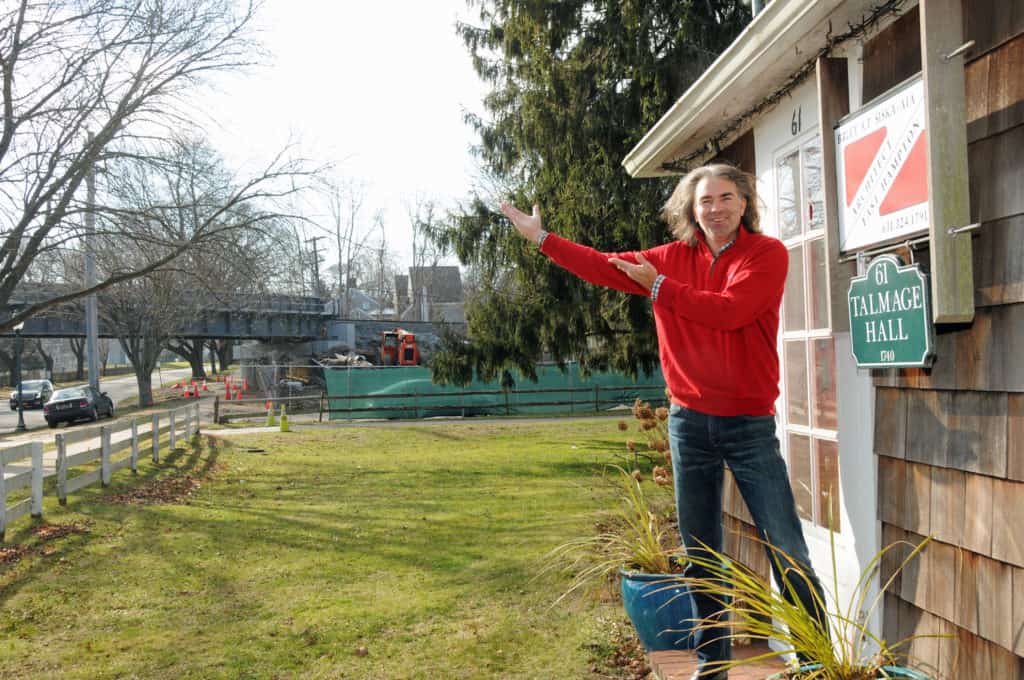If you live or work in East Hampton Village, chances are that North Main Street or Accabonac Road, gateways to Cedar Street, Three Mile Harbor Road and Springs-Fireplace Road, are on your regular route. If so, your driving habits recently had to change, at least temporarily.
Because of the frequency of vehicle strikes into the low clearance overhead railroad bridges on North Main Street and Accabonac Road, it was time for the Village to act, and for locals to find alternate routes of travel.
According to the MTA/LIRR, there were 33 crashes into the North Main Street Railroad Bridge (LIRR #41-0-007), with a posted clearance of 10 feet, and 27 crashes into the Accabonac Road Railroad Bridge (LIRR #41-0-009), with a posted clearance of 9 feet 9 inches, between 2010 and 2019. Bridge reconstruction, safety and stability checks necessarily followed, along with train delays and cancellations.
The entire replacement project took about 18 months and approximately $21 million, including bridge replacement, installation of abutments and retaining walls, and site drainage. Thanks to the expert planning of the MTA/LIRR, the process of bridge removal and replacement took only 23 days.
East Hampton Village was founded in 1648, when farming, fishing and some whaling were parts of everyday life. So, the Long Island Railroad was a relative newcomer when service was extended to East Hampton in 1895, the year the two bridges were constructed. The rights of way taken by the tracks at that time inevitably went through property that had been privately owned for centuries. The homes next to each of the two railroad bridges, the most directly affected by the work, are still occupied by descendants of the same families today.

What is often overlooked in reporting stories of major construction projects, is the human side of the story. Someone lives next door. East Hampton Village Deputy Mayor Barbara Borsack and her husband Ted live in the home next to the Accabonac Road Railroad Bridge, on land that was the Stephen Hedges Farm. Barbara’s ancestry includes the Strong Family and Captain James G. Scott, keeper of the Montauk Lighthouse from 1891 to 1911. She recounted the story of the progression of generations of family home building on Accabonac Road, starting with the house at the corner (actually 15 Pantigo Road) and continuing to the current track location.
Meanwhile, the neighboring home to the North Main Street Bridge replacement has its own historic importance. It is the landmarked 61 North Main Street, the 300-year-old “Isaac Hedges House”, currently the residence of architect Bruce Siska and his family. Bruce’s ancestors, including generations of Talmages, worked on the Isaac Hedges Farm when the house was built. The property fronts on Talmage Lane. Bruce’s sons are Bruce Avery Talmage Siska and Chase Alexander Talmage Siska.
The replacement of the East Hampton LIRR Bridges has been more than just a physical change, but also a “bridge” to a new future in our Village. As Paul Rickenbach, Jr., recently retired Village Mayor after 27 years, describes it, “It seems fitting, as East Hampton Village is on the cusp of 100 years of incorporation, that the recently completed LIRR trestle upgrades represents a tangible reminder of a bygone era. A segue of what lies ahead in the challenges facing our Village — not forgetting the past, while understanding that change is inevitable.”










!['The Maples' is a prestigious generational compound of two extraordinary estates: 18 Maple and 22 Maple. This rare offering, designed by luxury architect Lissoni partners New York and developed by visionaries Alessandro Zampedri-CFF Real Estate and JK Living, redefines opulence with the highest quality of craftsmanship and captivating views of the Atlantic Ocean. Represented by @nycsilversurfer and @challahbackgirl of @douglaselliman. [link in bio]](https://hamptonsrealestateshowcase.com/wp-content/uploads/sb-instagram-feed-images/438891010_1083749139481747_7890082604579275354_nfull.jpg)
![Featuring 360-degree water views on Mecox Bay, the Atlantic Ocean and Channel Pond, 1025 Flying Point offers the ultimate beach cottage that is flooded with natural light. With panoramic views, proximity to the ocean, and a private walkway to Mecox bay for kayaking or paddle boarding, this truly is a special retreat. Represented by @ritcheyhowe.realestate and @hollyhodderhamptons of @sothebysrealty. [link in bio]](https://hamptonsrealestateshowcase.com/wp-content/uploads/sb-instagram-feed-images/438994305_737511778456166_4602476013493875279_nfull.jpg)
![Attention advertisers! 📣 Secure your spot in the highly anticipated Memorial Day edition #HRES. Reach thousands of potential clients and showcase your brand in one of the most sought-after publications in the Hamptons, NYC, Palm Beach, and beyond. Contact us now to reserve your ad space! [link in bio]](https://hamptonsrealestateshowcase.com/wp-content/uploads/sb-instagram-feed-images/438549843_275102939023235_6718257301437562124_nfull.jpg)
![You eat with your eyes, and on the East End, it’s important that what you eat looks just as good as how it tastes. At @rosies.amagansett, the restaurant itself is plenty photo-worthy with blue ceramic tiling and yellow and white striped fabric wallpaper. But for a dish that will light up your photos, head directly to the salmon tartare! [link in bio]](https://hamptonsrealestateshowcase.com/wp-content/uploads/sb-instagram-feed-images/437094269_7296727147115953_1594410326824303644_nfull.jpg)

![We were honored to be the media sponsor for @blackmountaincapital's open house event with @jameskpeyton and @jfrangeskos at 11 Dering Lane in East Hampton! Other sponsors included @landrover, Feline Vodka, @rustikcakestudio, @la_parmigiana, @lahaciendamexicangrill11968, @homesteadwindows, Stone Castle, @talobuilders, and @thecorcorangroup.
A big thank you Carrie Brudner of Black Mountain Capital for putting together this fabulous event! [link in bio]](https://hamptonsrealestateshowcase.com/wp-content/uploads/sb-instagram-feed-images/437081213_762912965932136_6847332836522786568_nfull.jpg)

![Blooms Galore at the Long Island Tulip Festival! 🌷✨ Mark your calendars for April 15th as the vibrant tulips at @waterdrinkerlongisland burst into full bloom! Enjoy a day filled with colorful splendor, food trucks, live music, and more. [link in bio]](https://hamptonsrealestateshowcase.com/wp-content/uploads/sb-instagram-feed-images/437083429_974242677583725_6855805712693638343_nfull.jpg)
